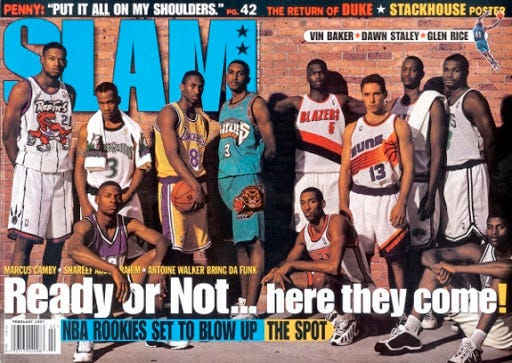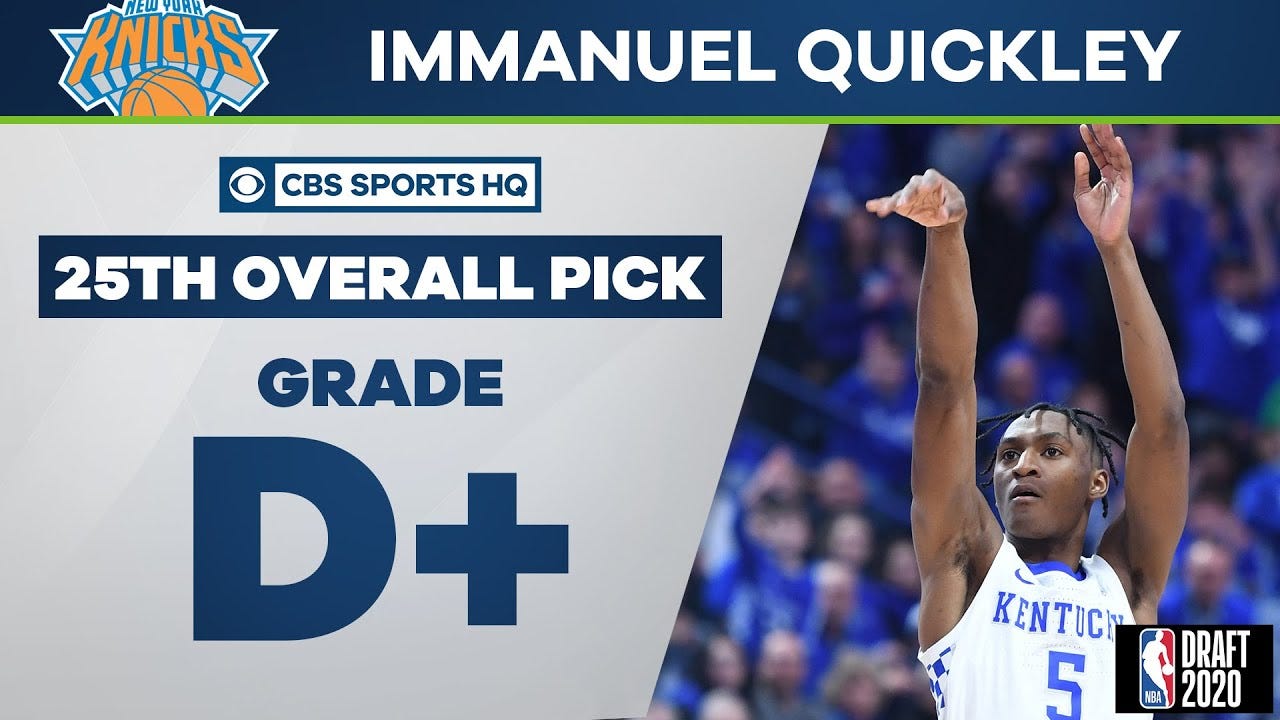The 2020-2021 NBA Rookie Class is Special In Its Own Way
The above SLAM pullout cover is iconic for an pro basketball fan, but especially those of us who grew up on ‘90s hoops and had this collector’s edition poster on our bedroom walls.
Last night while watching Anthony Edwards go for 42 points, which included an 8-of-9 3-point shooting performance; and seeing Desmond Bane sink two critical 3-pointers in the final minute, memories of the legendary “Ready or Not” poster/cover came to mind.
*
Marvel at the talent depicted above: Kobe Bryant is one of the greatest to ever play. Steve Nash is a two-time Most Valuable Player. Ray Allen is one of the most transformative players as far as embracing the 3-point shot. Jermaine O’Neal and Marcus Camby were impactful big men, Antoine Walker and Shareef Abdur-Rahim showed flashes of greatness, and Stephon Marbury is one of the most fascinating and influential figures for his own unique reasons.
And Allen Iverson, arguably the second-best player from this class, couldn’t make the photo shoot!
In this year, the 25th anniversary of the 1996 draft class, it’s small wonder the spotlight is turned back on the group.
‘96 also marked the final draft of a golden age in college basketball. A decade before the NBA instituted the so-called One-and-Done Rule, the immediate success and celebrity of high school-to-pro talent like Kobe and Kevin Garnett, as well as changing philosophies in pro front offices, created the environment that eventually led to the One-and-Done decision.
A few years ago when Tim Duncan retired, I was doing some research on his Wake Forest days for a column and happened upon an article lamenting Duncan as the last of a dying breed — not for his old-school style of play, but rather as one of the last, true college stars in the mold of Kareem, Patrick Ewing, or teammate David Robinson to head into the draft.
Part of what made the 1996 draft class so special was witnessing the next phase in the basketball evolution of stars many of us already knew. We’d watched Steve Nash lead Santa Clara to a 15-over-2 upset of Arizona in the NCAA Tournament; Marcus Camby and Tim Duncan play out a theoretical rivalry over who the best big man in the country was; Allen Iverson defy logic, scoring in bunches at his size and making fashion statements with his cut-sleeve undershirts and patent-leather Jordan XIs.
I don’t know what specifically is most to blame: That the internet was far from ubiquitous at the time? That ESPN hadn’t yet gained NBA broadcasting rights and thus changed how it presented the many college basketball contracts it owned to present the sport in a much more low-rent way? Perhaps it’s just my own, youthful naivety.
Whatever the reason, the ‘90s — and especially this point of the ‘90s — felt like there was a less contentious relationship between college basketball and NBA fandoms.
For that reason alone, there may never again be another draft class with the same aura as ‘96. But, on its own merits, the 2020 draft class looks like one that will be similarly remembered decades from now.
*
I’m not sure if the following is so much an admission or confession as it is just a statement of personal preference, but I avoid mock drafts like The Plague.
I once read mock drafts described as Horoscopes For Bros, and I wish I could remember where so I can properly credit what is an outstanding and perfect description.
Outside of the proliferation of gambling content, there’s no cottage industry in sports media with as little consequence for being wrong as the mock-draft space.
The general opinion to which I was exposed ahead of the 2020 draft suggested this was a two, maybe three-man class. While one might chalk it up to coinciding with a once-in-a-century pandemic, sentiment seemed to be determined well before COVID-19 shut down the world.
The three reflect just how much the landscape’s changed since 1996.
James Wiseman: Played in three games at Memphis due to violations of NCAA rules.
Anthony Edwards: Averaged 19.1 points per game, but did so for a Georgia team that would have needed to win the SEC Tournament just to make March Madness.
LaMelo Ball: Never played a second of college basketball, instead going to Australia (after a dizzying tour through Lithuania and stint in his dad’s failed JBA), and performing inconsistently in the NBL.
Between the three, their college peak came in Edwards’ electric play at the 2019 Maui Invitational.
A stark contrast to Nash, coming into the NBA as a March legend or Iverson continuing the legacy of Hoya Paranoia for a new generation. But, it’s a fitting reflection of the class at large in that so much of what it’s delivered as come as a surprise.
Now, despite my prior tirade about the mock-draft industry, I do have to give credit that the two leading candidates from this class for Rookie of the Year are among the three who garnered the lion’s share of attention.
Edwards and Ball aren’t going to be stars; they already are there.
Going head-to-head with last year’s Rookie of the Year, Ja Morant — a pro standout who came into the NBA having made his rep at the college level — Edwards may have sealed this year’s edition of the award.
Edwards has proven himself an effective scorer, both attacking the rim and shooting from outside. In a fun coincidence, since a show-stopping dunk over Yuta Watanabe in February that became the jumping-off point of a killjoy NBA blogger to disparage Edwards’ efficiency, he’s made three or more 3-pointers in 19 games.
With Ball, the narrative was unfairly shaped by his boisterous (and, from Big Baller Brand to the JBA, sometimes charlatan) dad. His highlights at Chino Hills High before the globetrotting experiment began appeared more comparable to Instagram trick-dribbler Tristan Jass than to Steve Nash’s time at Santa Clara.
As part of the NBL’s Next Stars initiative, Ball provided star power — and, much more so than R.J. Hampton, a solid player in the Australia league — but nothing Down Under suggested he’d be immediately transformative in the NBA.
Yet, Ball has remarkably met the hype in Year 1 with the Hornets, helping a franchise seemingly doomed for the basement to a likely playoff berth this month. His court vision is reminiscent of Nash or Jason Kidd from two rookie classes earlier, and his scoring ability is taking shape.
But, again, if two players from the 2020 draft class were going to excel, Edwards and Ball were two most people agreed on.
What about Desmond Bane? The knock on four-year college players in the last two decades or so is that if they were NBA talent, they’d have left early. That stigma isn’t as prevalent was it was a decade or so ago, but the idea of a four-year contributor at TCU becoming an immediate key player for a playoff-bound team like Memphis may have seemed far-fetched.
Ditto Immanuel Quickley. While from the NBA factory that is Kentucky, Quickley came into the draft dismissed. His CBS Sports draft ranking is a bit of a meme now as Quickley plays an integral role in the remarkable turnaround of the Knicks.
Desmond Bane’s Big 12 Conference counterpart Tyrese Haliburton was solid at Iowa State in 2019-20, averaging more than 15 points, six assists and almost six rebounds per game. These also weren’t exactly the Marcus Fizer*/Jamaal Tinsley Cyclones we’re talking about, either, so it’s not like Haliburton’s play resonated too far beyond Ames.
*Someday, I’ll go over college stars I wrongly believed would translate in the NBA; Fizer’s at the top of that list.
Sacramento similarly isn’t a spot that commands much attention, but before his season-ending knee injury, Haliburton was arguably the third-most exciting and best of the rookie class.
League Pass is an annual must-purchase in part to see the unheralded playmakers in markets that don’t get TNT or ESPN exposure, like Sacramento. Likewise, you didn’t see Detroit on national broadcasts this season — rightfully so as the East’s last-place team.
However, I’ve found the Pistons to be a worthwhile League Pass watch this season due to their rookie class.
Basketball has different flavors of bad teams, like the clearly tanking Thunder or the depressingly unorganized Rockets. Detroit is different, fostering a young corps of guys playing hard. The influence from college and a coach like Jay Wright is evident in Saddiq Bey, who deserves 1st Team All-Rookie recognition.
Isaiah Stewart is a workhorse, developing quickly down the stretch and with a style of play that would have fit with the mid-2000s Pistons. French product Killian Hayes is seeing minutes in the final month and the prospect of him evolving into one of the league’s premier passing point guards is evident.
Certainly, the make-up of this group is vastly different from ‘96. However, what makes the ‘20 draft class different also makes it enjoyable — and, on its current trajectory, possibly as well-remembered as that incredible group a quarter-century ago.





